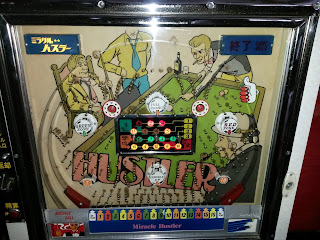 |
| Mystic Lines card |
 |
| Mizuho Pachinko circa 1971 |
You get the Hustler!
 |
| Satomi Sammy Miracle Arrange Ball |
Hustler was produced by Satomi Co. Ltd.
I wish I knew the year it was produced. I suspect 1976, since all the assemblies are labeled 7610 and 7609... I could be wrong, dates in these machines are usually expressed in Shōwa era (1976 should be indicated as "S51".
There is little information about these games but from what I read so far about Arrange Balls, they occupied the equivalent ecological niche in Japan as Bingo machines in most parts of Canada / USA. Back of the shop hush hush dubious legality. But then there's this video on Youtube clearly showing Arrange balls in a Smart Ball parlor.
First, insert Token:
16 balls are released to the ball shooting mechanism. Like an Arepachi (or unlike a traditional pachinko machine) the player cannot directly handle the balls. They can be seen behind a clear plastic chamber.
Shoot balls to achieve winning number combinations.
Balls land in pockets numbered 1 to 16, lighting corresponding numbers at the center of the backflash. Leftmost and rightmost alleys marked Re-play return balls to be shot again. Multiple balls can land in the same number pocket.
2 - 6 - 14 awards 1 token
1 - 5 - 11 - 15 awards 1 token
3 - 7 - 9 - 13 awards 2 tokens
4 - 8 - 10 - 12- 16 awards 3 tokens
When all the balls have been played, inserting another token or pressing red button on the left side of the game pays out tokens*
Features are awarded when balls go through award pockets. These pockets do not hold the ball. The ball goes through, tripping a micro switch.
Green Zone
Lights the Green Zone award. Hitting 1, 6 and 11 awards 1 token
Red Zone
Lights the Red Zone award. Hitting 3, 8, 9 and 16 awards 2 tokens
Double-Up
Instantly pays out 1 token and lights the double-up. Bottom 2 lines payout double indicated*. Does not apply to Red zone
Full Chance
Instantly pays out 1 token and lights the Double-up, Red Zone and Green Zone.
*This machine can pay out a maximum of five tokens (total) per play as indicated by the blue oval-ish label at the top of the machine.
As for repairs...
The payout mechanism was gummed up with old grease. It was completely disassembled, cleaned and re-lubed.
Edge connectors were cleaned
A few old Electrolytic Capacitors were changed on the Main board.
 |
| Control Board. Notice the sticker on the ROM |
Dim or burnt lamps were changed. Replacement bulbs used are 2182. Although I find they run a bit hot. I do not keep the game on when not playing it as a precaution.
Everything inside was coated in nicotine. Balls would not release properly, coins would not even slide down the coin chute. Cleaned everything with 99% Isopropyl and Novus 2.
 |
| Back of door |
 |
| Main control board and payout mechanism |
The machine is for Japanese domestic market, which means it runs on 100VAC instead of the North american 120VAC standard. A large ceramic resistor was installed somewhere in the machine's turbid past. Crude, but it works. Converting angry pixies into heat.
 |
| OK. This is dodgy AF |
There is a switch at the bottom right of the cabinet. If the front door assembly is opened mid play, the game will not pay out winning combinations as an anti-tampering feature.
For a condensed history of Pachinko, check out Pachinko Boy's history page



No comments:
Post a Comment